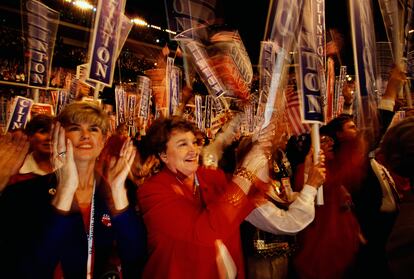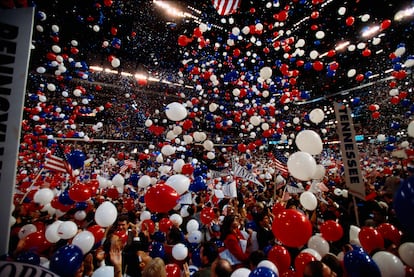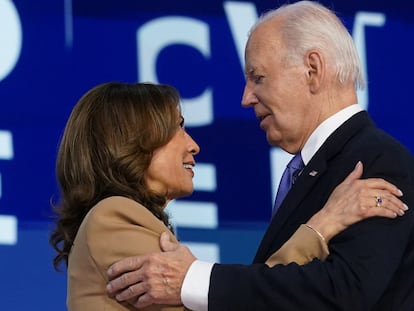When Trump was just another millionaire and the Democrats did the ‘Macarena,’ confident of victory
In the summer of 1996, Bill Clinton had few doubts he would be re-elected. The country was enjoying peace and economic prosperity, and there was no hint yet of the political polarization that was to come

At the Democratic National Convention (DNC), Vice President Kamala Harris will officially become the second woman in history to become the party’s presidential candidate. The DNC is taking place in Chicago, the same city where the Democrats have celebrated other historic events, such as the 1968 convention, which was marked by the anti-Vietnam War riots that led to the trial of the Chicago Seven (an episode made into a 2020 film by Aaron Sorkin); and the 1996 convention, when the party danced did the dance to Macarena, while dominating the country’s political map.
Twenty-eight years have passed since then, and the 1996 DNC remains one of the most iconic. It was the second time Bill Clinton had been officially named the party’s presidential nominee. At the time, he had a comfortable lead in the polls and was expected to win a crushing victory against his opponent, Republican Bob Dole. After the controversial years of Ronald Reagan and the end of the Cold War, the political pendulum had swung in favor of the Democrats.
One of the most memorable speeches from the 1996 DNC was made by actor Christopher Reeve, the famous star of Superman, who had been paralyzed after being thrown from a horse — an accident that turned him into a disability rights activist. But the standout moment was when all the delegates danced to the Macarena by the Spanish group Los del Río, while Hillary Clinton applauded non-stop from the stands.
I am begging whoever is producing the dnc to please have us all do the Macarena pic.twitter.com/KZqYWtXDqG
— Keith Edwards (@keithedwards) August 19, 2024
The footage broadcast by C-SPAN cameras showed a room bursting with joy, with delegates waving, twirling and swaying to the song. It was a music video that showcased the party’s youthful vitality, its racial and sexual diversity (one man is seen wearing an LGBTQ+ flag), and the joy of people who consider themselves winners.
Republicans also danced to the Macarena in San Diego that year, but it made zero impact. The Democrats appropriated the song, and performing the dance came their nightly ritual at the convention. In one of his speeches, then-vice president Al Gore even jokingly “performed” his own version of the dance, which required no movement (a self-deprecating nod at his reputation for seriousness). It didn’t matter because he and Clinton set the pace for the nation.
The New York Times described the 1996 Democratic convention as a “variety show.” If the Republicans turned their convention into an infomercial, the Democrats opted for an Oprah Winfrey-style show. The cast of the Broadway musical Rent performed a song called Seasons of Love, about compassion for AIDS sufferers; Emmylou Harris sang Abraham, Martin and John, in honor of Lincoln, Luther King and Kennedy; and Aretha Franklin enraptured the audience with her rendition of the national anthem. The event was filled with gospel music (and evangelical sermons) to showcase the African-American community in the splendor of its family values and community enthusiasm.
President Clinton’s acceptance speech ended with a performance of the Chicago rock band’s song Beginnings, taken from their first album, Chicago Transit Authority. The song includes the chants made by protesters at the 1968 riots. It was a way of vindicating them. Nearly 30 years later, the Harris-Walz campaign is facing the pro-Palestine protests, and have the challenge of finding a song in which Americans can once again see themselves reflected.

Sign up for our weekly newsletter to get more English-language news coverage from EL PAÍS USA Edition
Tu suscripción se está usando en otro dispositivo
¿Quieres añadir otro usuario a tu suscripción?
Si continúas leyendo en este dispositivo, no se podrá leer en el otro.
FlechaTu suscripción se está usando en otro dispositivo y solo puedes acceder a EL PAÍS desde un dispositivo a la vez.
Si quieres compartir tu cuenta, cambia tu suscripción a la modalidad Premium, así podrás añadir otro usuario. Cada uno accederá con su propia cuenta de email, lo que os permitirá personalizar vuestra experiencia en EL PAÍS.
¿Tienes una suscripción de empresa? Accede aquí para contratar más cuentas.
En el caso de no saber quién está usando tu cuenta, te recomendamos cambiar tu contraseña aquí.
Si decides continuar compartiendo tu cuenta, este mensaje se mostrará en tu dispositivo y en el de la otra persona que está usando tu cuenta de forma indefinida, afectando a tu experiencia de lectura. Puedes consultar aquí los términos y condiciones de la suscripción digital.
More information
Archived In
Últimas noticias
Most viewed
- Sinaloa Cartel war is taking its toll on Los Chapitos
- Oona Chaplin: ‘I told James Cameron that I was living in a treehouse and starting a permaculture project with a friend’
- Reinhard Genzel, Nobel laureate in physics: ‘One-minute videos will never give you the truth’
- Why the price of coffee has skyrocketed: from Brazilian plantations to specialty coffee houses
- Silver prices are going crazy: This is what’s fueling the rally











































